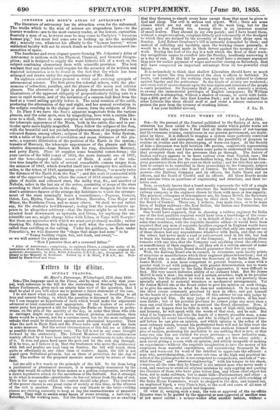JOHNSTON AND HIND'S ATLAS OF ASTRONOMY.*
The literature of astronomy has its attraction even for the unlearned. The truths which to the man of science are stupendous laws—to the learner wonders—are to the most cursory reader, at the lowest, curiosities. Scarcely a man of us, however near he may come to Carlyle's "ferocious human pig," but must feel some awe in looking up into the midnight sky ; scarcely one, whatever his affinity to the "human beaver," whose statistical faculty will not be struck dumb as he reads of the measured im- mensities of space.
The handsome and even elegant quarto forming Mr. Johnston's Atlas of Astronomy is uniform with his Physical, Classical, and General Geogra- phies; and is designed to supply the want hitherto felt of a work on the subject combining elementary facts with scientific precision. The best warrant that any student could require for the accuracy of its written and depicted information is to be found in the fact that the whole has been arranged and drawn under the superintendence of Mr. Hind.
Its eighteen coloured plates present a vivid and enticing synopsis of astronomical science. The first gives the celestial sphere, with the phe- nomena of refraction, parallax, and the phases of the moon and inferior planets. The aberration of light is plainly demonstrated in the little illustrations of the apparent obliquity of perpendicularly falling rain to a man in rapid motion, and of the deviation of a cannon-ball fired from the land at a vessel sailing quickly before it. The axial rotation of the earth, producing the alternation of day and night, and her annual revolution in the ecliptic resulting in the change of season, form the subjects of Plate 2. In Plate 8 we have the Sun's apparent magnitude from the various planet's and the solar spots, seen by magnifying, here with a certain like- ness to a shell, there to some scorpion of unknown species. Plate 4 is the telescopic appearance of the Moon, both in the entire diso and in par- ticular spots more highly magnified. Then follow the eclipses of the Sun, with the beautiful and not yet fathomed phenomenon of its projected rose- coloured flames, among others; eclipses of the Moon ; the Solar System, with a table of the periods of revolution and mean distances of the pla- nets; a separate illustration of the position of the Earth in the system; transits of Mercury, the telescopic appearances of the planets and their relative dimensions—huge Saturn with his ring, diminutive Mercury, and petty Earth. Plate 10 supplies some beautiful comet-forms ; the pure curves of the bifid comet of 1811, the more fantastic one of 1807, and the bone-shaped double comet of Biela. A scale of the rela- tive true lengths of the tails of several remarkable comets ranges from the minnow of 1847, which dwarfed itself into a trumpery five million of miles, to the triton of 1843, spatiating over 180 millions, " or nearly twice the distance of the Earth from the Sun" ; and this scale is contrasted with one of the apparent lengths, where the comet of 1618 stands supreme. A plate of double and coloured stars, the milky way, &c., and another of Nebulas, usher in the last six of the series, consisting of maps of the stars according to their allocation in the sky. Here are designed for the stu- dent's assistance figures of the strange sky-habitants to which the arrange- ment of the stars nominally bears a resemblance,—Pegasus, Gemini, Orion, Leo, Hydra, Canis Major and Minor, Hercules, Ursa Major and Minor, the Southern Cross, and so many others. Or shall we not rather say, for the student's bewilderment; seeing that the nomenclature ap- pears to be altogether arbitrary—that the figures might be as well con- structed head downwards as upwards, and Orion, for anything the un- scientific can see, might change titles with Libra, or Virgo with Scorpio ? But these are mysteries with which we must not profanely meddle ; rather thanking Mr. Johnston for telling us so well what the constellations are called than cavilling at the calling. Under his guidance, as Kate under Petruchio's, we will discover the "shape that shape had none" to be "Young budding virgin, fair, and fresh, and sweet,"—
or we will correct the phrase into "Now I perceive thou art a reverend father."
• Atlas of Astronomy ; comprising, in eighteen Plates, a complete series of Il- lustrations of the Heavenly Bodies, drawn with the greatest care, from original and authentic documents, by Alex. Keith Johnston, F.R.S.E., Re., Geographer in Or- dinary to her Majesty in Scotland. Edited by J. R. Hind, F.R.A.S., 80. Pub- lished by Blackwood and Sons.


































 Previous page
Previous page